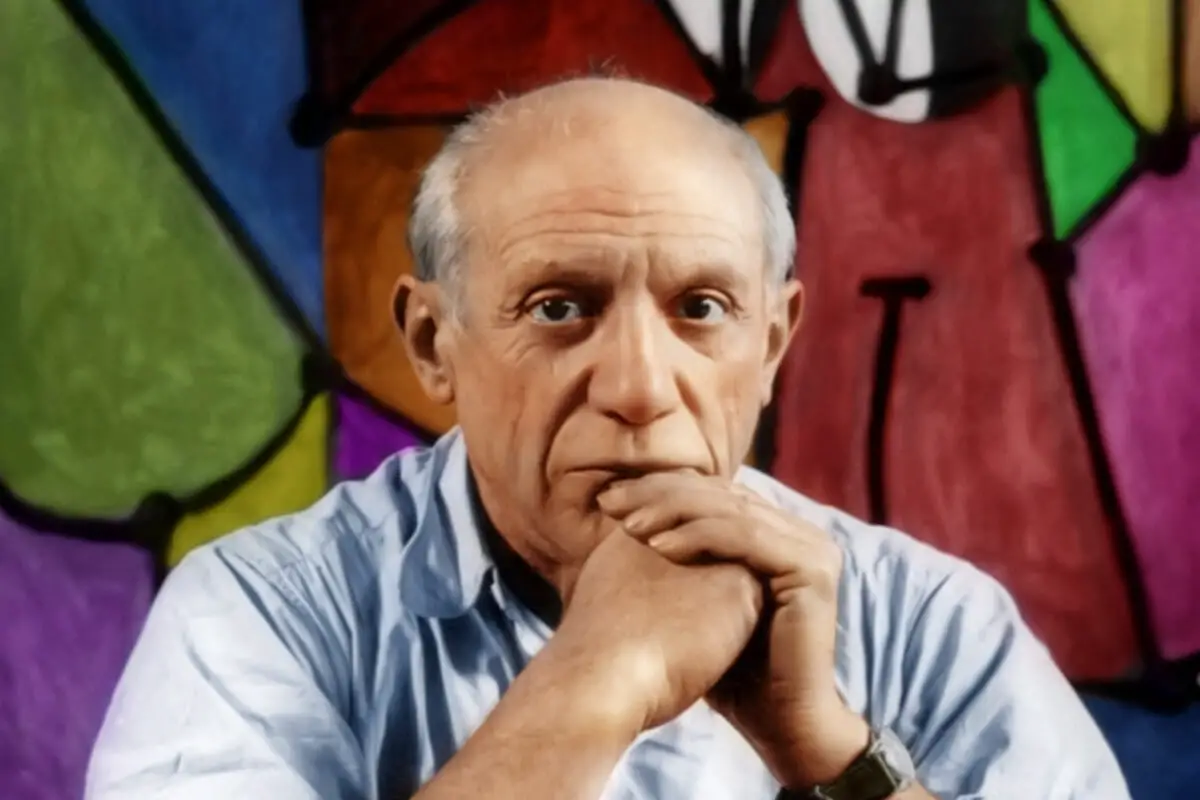The life and art of Pablo Picasso, one of history’s most revolutionary artists, encapsulate distinct eras of intense personal growth and reinvention. Picasso’s prolific self-expression through his self-portraits offers a broad spectrum to discern the profound aspects of his life journey, from his early years to his evolving artistic style and, ultimately, his relentless pursuit of innovation.
This exploration scrutinizes the defining moments in Picasso’s early years, tracing those experiences’ influences on his self-portrait techniques. As we journey through the labyrinth of Picasso’s self-portraits, we’ll shed light on the intricate weavings of form, color, and style, revealing the emotional depth and psychological nuances hidden beneath the surface. The voyage will further embrace an analysis of Picasso’s artistic style in his self-portraiture, acknowledging his periods of artistic transitions and highlighting the enduring impact and profound legacy left by Picasso’s self-portraits.
Table of Contents
- Early Years of Pablo Picasso
- Analyzing Picasso’s Self-portraits
- Picasso’s Artistic Style in Self-portraiture
- Impact and Legacy of Picasso’s Self-portraits
- Related Questions
Early Years of Pablo Picasso
Unmasking Picasso: The Early Years and Evolution of Self-Portraiture
Few names elicit the same awe and reverence as Pablo Picasso, the Spanish virtuoso widely celebrated for his formidable influence on modern art. More than just an avant-garde painter, Picasso was a quintessential harbinger of the abstract, trailblazing through various styles, from Realism to Surrealism, and co-founding the Cubist movement.
An exciting component of Picasso’s expansive opus is his exploration of self-portraiture throughout his career. This exploration, deeply rooted in the early years of his life, reveals a fascinating evolution in technique.
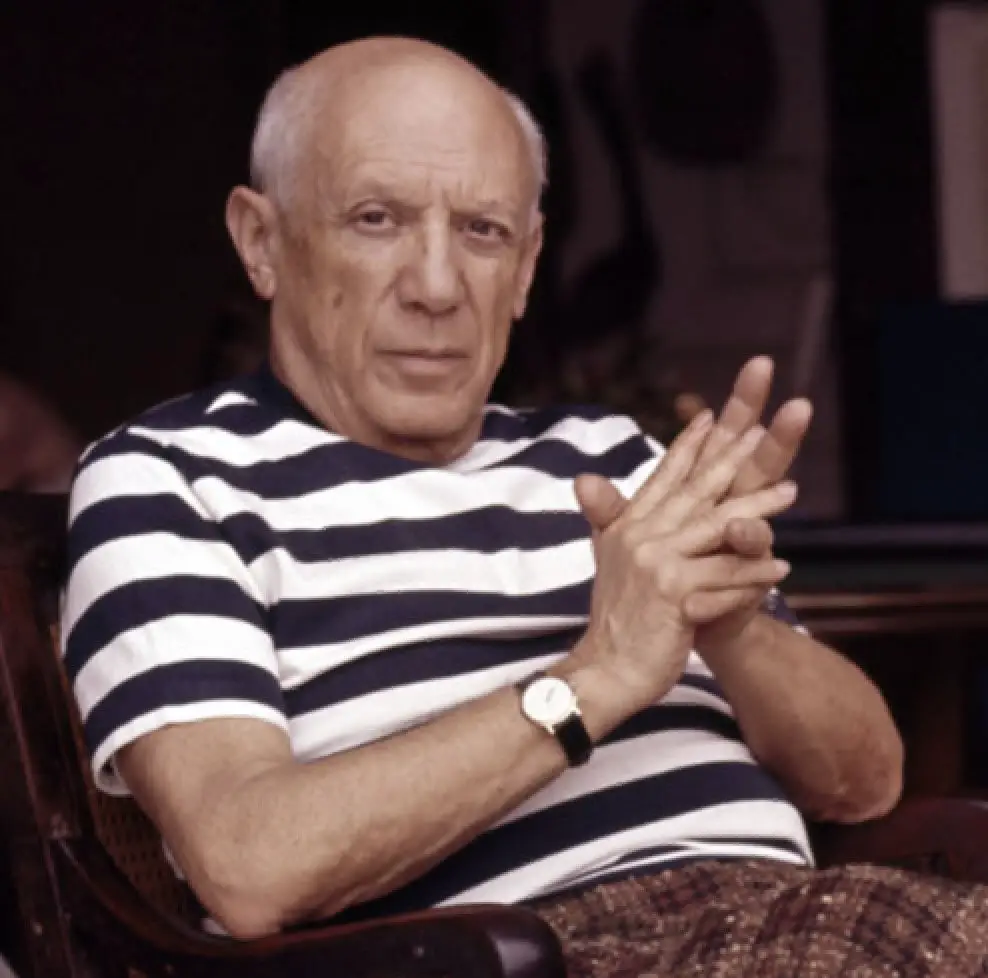
Born on October 25, 1881, in Málaga, Spain, Pablo Diego José Francisco de Paula Juan Nepomuceno María de los Remedios Cipriano de la Santísima Trinidad Martyr Patricio Clito Ruíz y Picasso spent his formative years under the watchful guidance of his father, himself a traditional artist and art professor.
These initial brushes with art had a profound, lasting influence on Picasso’s artistic journey. An eclectic blend of Spanish and French inspirations, including Spanish folklore, religious symbolism, and French realism, amplified this influence.
At age thirteen, the adolescent prodigy painted his first self-portrait, “Self Portrait in a Cap.” The portrait, painted at a significant moment when Picasso was enrolled at the Barcelona School of Fine Arts, demonstrated classic influences, such as perspective and chiaroscuro, which are hallmarks of a traditional approach to realism.
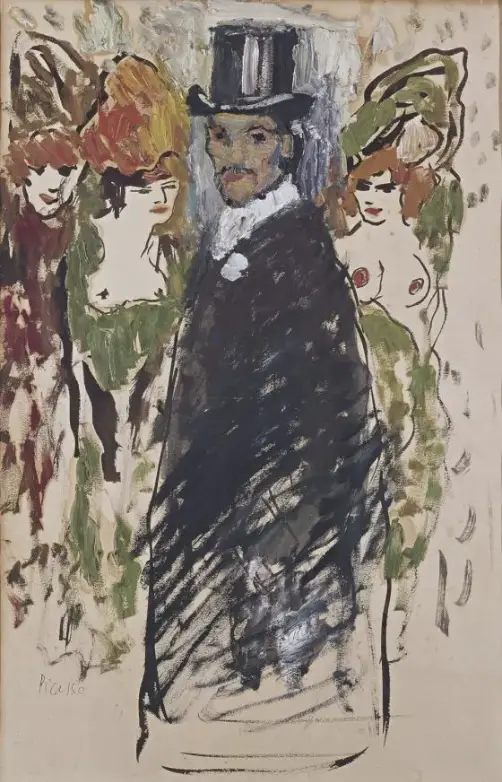
Fast-forward to 1901. Picasso’s second self-portrait, “Yo Picasso” (I Picasso), marks the onset of what later came to be known as his Blue Period. This period, replete with somber, monochromatic blue and blue-green hues, saw Picasso grapple with poverty, suffering, and loneliness themes.
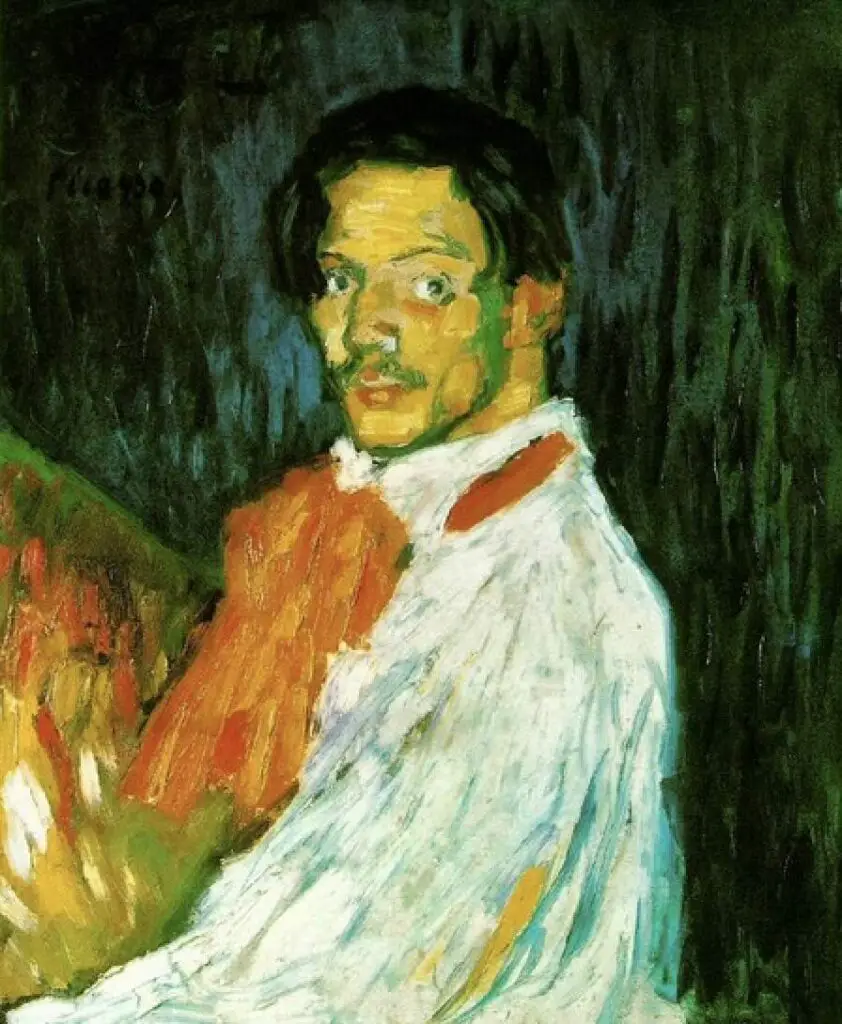
Inspired by the plight of the underprivileged, Picasso’s Blue Period paintings are often haunting portrayals of societal misfits – beggars, prostitutes, and the physically impaired. Intriguingly, Picasso weaves his melancholia into these poignant scenes, inviting viewers to connect with his raw, bare emotions.
Picasso’s later self-portraits are strikingly diverse, reflecting his stylistic evolution. In 1906, the artist pivoted towards tribal art and simplicity, with mask-like faces and anatomical deconstructions characteristic of his African-inspired period. “Self-portrait with a Palette” (1906) embodies this stylistic shift, featuring an abstract, simplified version of the artist, a sharp departure from his earlier realism.
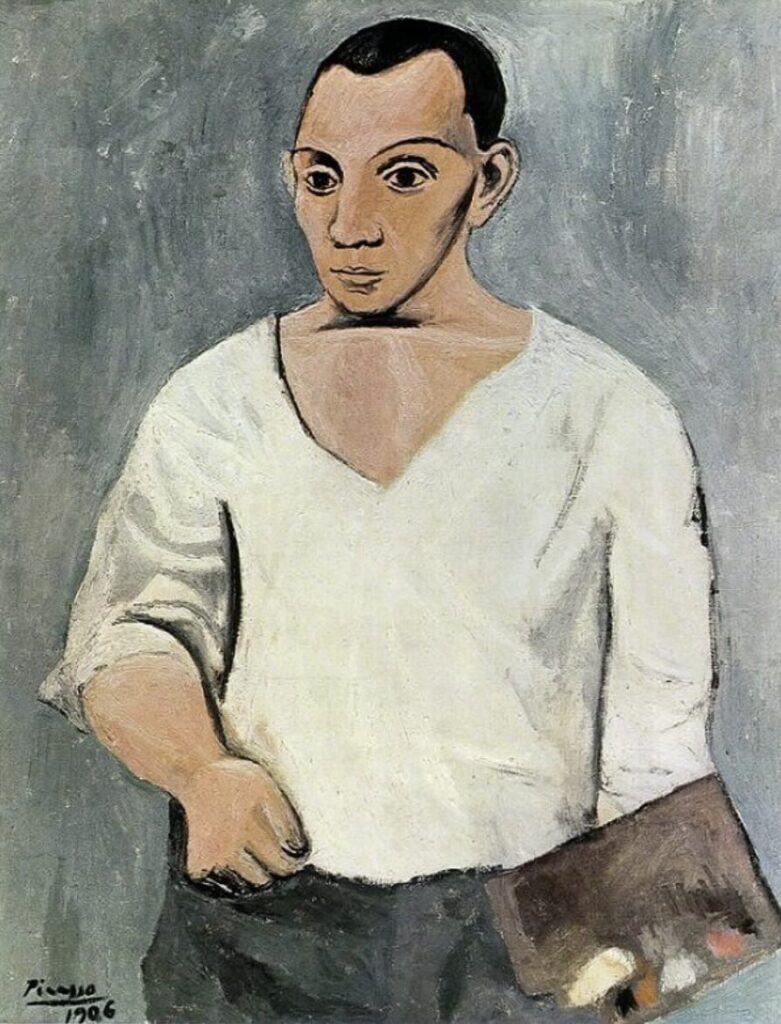
A decade later, as seen in the “Self-Portrait” (1917) during the period of Return to Order after the chaos of World War I, Picasso re-engaged with traditional portraiture techniques. The artist’s face is painted with anatomical precision, albeit emotionless. This stark, almost sterile self-portrait reflects the disorientation and desolation of the global conflict.
By 1972, Picasso’s final self-portrait sees an artistic circle completed. It features exaggerated features and sweeping linework – a symbolic, reflective rendering of the artist, vastly different from his initial exploration of self-portraiture. This evolution mirrors Picasso’s transformative journey, from a prodigy nurtured by his father through the trials of young adulthood, societal upheavals, and personal explorations, culminating as arguably the 20th-century’s most acclaimed artist.
Picasso’s self-portraits catalog his journey as an artist and a human being, evolving and changing with every brushstroke. This constant evolution, ignited and nurtured in his early years, makes Picasso’s work a timeless symbol of expressiveness and innovation, even to this day.
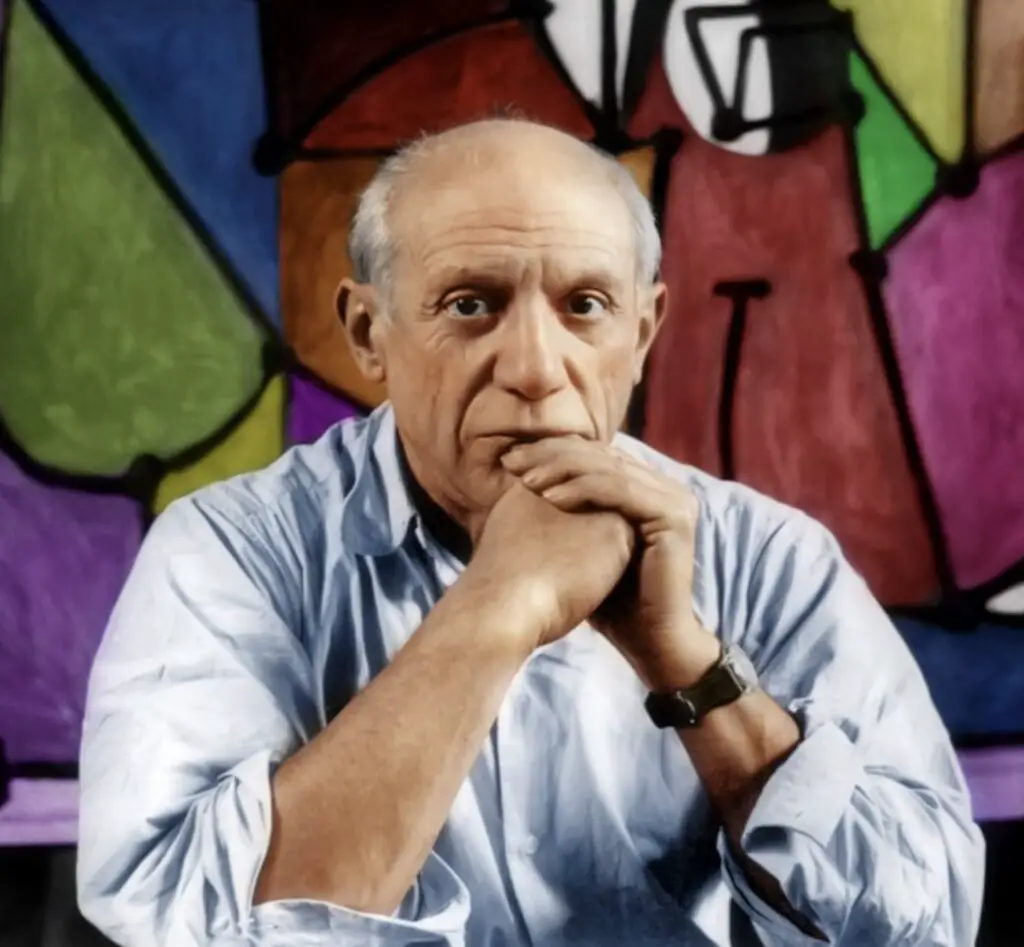
Analyzing Picasso’s Self-portraits
Expressions of the soul, illustrations of personal journeys, encapsulations of evolution: Self-portraits offer an intricately intimate look at an artist’s life. These reflective mirrors allow us to traverse the artist’s timelines mentally and emotionally. One artist who made prolific use of this genre was Pablo Picasso, a stalwart of modern art.
Analyzing the Self-portraits: A Psychological Perspective
Drenched in psychological imperatives and emotional experiences, Picasso’s self-portraits offer us access to his inner world at various junctures. From the early influences based on traditional realism to the grayer periods influenced by socio-political climates, each self-portrait is a dialogue between Picasso and himself.
Exploring Vulnerability and Depression
Seeking refuge in art during his Blue Period, Picasso painted several self-portraits inspired by melancholy. The subjects were often depicted in sorrowful, dimly-lit settings, bearing eerie resemblances to the painter himself. This provides a glimpse into Picasso’s altered mental state during this stage of his life, reflecting his solitude and intense struggle with depression.
The African Art-Inspired Period: Experimentation and Redefinition
The influence of African art was evident in some of Picasso’s subsequent self-portraits. Launching a departure from traditional norms and canons, these self-portraits combined powerful emotions with harsh geometric interpretations, providing an evolving psychological insight into the artist’s transformation.
Picasso’s amalgamation of traditional European canon with African artistic elements challenged a rigid cultural code and reflected his perspective on the dynamism of art.
The Return to Order: Symbolism and Closure
As the global turmoil of World War I began subsiding, Picasso gradually returned to a softer, more mature Expressionism visible in his later self-portraits. The artist seemed at peace, reflecting a newfound stability and psychological calmness after the war’s chaos. This period denotes the culmination of his emotional journey, depicting the man Picasso became: stronger, wiser, and more realized.
Threading into Picasso’s Psyche
Reflecting on his personal experiences, thoughts, fears, and beliefs, Picasso’s self-portraits can be considered open diaries, letting us delve into a realm once considered private and shedding light on his personal and artistic growth.
Unraveling these visuals becomes like engrossing conversations that embody a distinct personality and the intertwined journey of the artist and his art. Each portrait, from its canvas to color, mirrors Picasso’s emotional state, not just artistically but also as an ordinary man navigating through the changing facets of life.
Unraveling an artist’s life is like an intimate conversation with their minds and hearts—allowing us to appreciate art and understand humans and the intriguing emotional spectrum they experience. Picasso’s self-portraits express this spectrum vividly and sincerely, leaving us with a calming sense of having traveled through an extraordinary yet relatable life journey.
Picasso’s Artistic Style in Self-portraiture
Thrusting himself into the uncharted territory of artistic self-exploration, emulating the psychological tumult Picasso underwent personally reflected in his self-portraits. With each stroke and hue, Picasso displayed remarkable candor – unveiling vulnerability and strength, sadness and joy, chaos and order.
Take a turn into the winding road of Picasso’s first experiments with his self-image during an era plagued by depression. His self-portrait from the blue period is a sad invitation into his psyche. Picasso manages to provoke empathy in viewers with his use of color to depict the innate human experience of despair while staying committed to his prowess for realism.
As his life took new turns, so did his self-portraits. A shift happened when Picasso was introduced to African art that triggered a spark of bold exploration. Picasso effortlessly wielded the rich cultural aesthetics of African art into his narrative, creating iconic work during this period that revealed surrealism. The power and depth he found during his African Art-inspired Period let him redefine his artistic perception.
Tasked with an artistic mission that recognized no geographical or stylistic frontier, Picasso plunged into another face of his artistic evolution. His ‘return to order’ phase saw a retreat to more traditional forms of representation, reflecting resolve and closure. Here, he interprets the human form through classical means, suggesting a symbolic surrender to the techniques of his predecessors. His stylistic oscillations between traditional and non-conformist depict a purposeful search for himself and his place within the broader artistic spectrum.
Interweaving the threads of Picasso’s psyche reveals an unquenchable thirst for diversity in self-expression. Each self-portrait is a milestone in his journey and testifies to his chameleonic adaptability to different styles, techniques, and influences. Picasso attached pieces of his evolving identity to his art, challenging current norms and pushing boundaries of what was considered ‘acceptable’ or ‘traditional.’
In essence, Picasso’s style evolution in his self-portraits echoes the vigor of his artistic experimentation. They are an odyssey showcasing personal metamorphoses, cultural appropriations, and symbolic representations.
Picasso’s self-portraits are not merely images in a mirror but evolving artifacts of his artistic voyage, each encapsulating a unique chapter of his life’s saga. An exemplar of how art and the artist are inseparable, Picasso perpetually infused his essence into his work, ensuring everlasting relevance in the annals of art history.
Impact and Legacy of Picasso’s Self-portraits
As we delve deeper into Picasso’s legacy of self-portraits, we uncover elements that continue to engage art lovers globally. These self-portraits became more than visual art; they were psychological timelines of the artist’s life, showcasing his development, emotional valence, and shifts in worldview. These multiple layers of narrative in Picasso’s works remain vital in maintaining the undying fascination that swirls around this icon.
We should highlight the significant realism shift in Picasso’s work during his Blue Period. This melancholic phase further showcased Picasso’s ability to leverage color to convey emotion and mood, particularly evident in his self-portraits.
His self-portraits deviated from the conventional, bursting with raw emotion and vividly illustrating the themes of socio-economic struggle, isolation, and despair. At the time, such exploration of vulnerability was groundbreaking, palpably shifting the trajectory of modern art and maintaining its relevance today.
Like a chameleon embraces change, Picasso was fearless in experimentation, which is evident in his African Art-inspired period. During this time, his self-portraits took a dramatic turn, resonating with the primal energy and simplicity associated with African art.
Picasso’s reinterpretation and incorporation of these elements into his self-portraits signified the coalescence of diverse artistic perspectives and affirmed his status as a pioneer of Primitivism. These pieces were more than just art; they were cultural crossroads on canvas.
Eventually, Picasso returned to a more classical approach, an epoch often called his “Return to Order.” Reflecting a more restrained, reflective mood, Picasso’s self-portraits from this period demonstrate a renewed appreciation for formality, clarity, and balance.
Conceptually, these works offered closure, marking Picasso’s evolving perception of self and the world around him. Such symbolic self-representations offer a glimpse into Picasso’s psyche, reinforcing his importance in the psychoanalytic perspective of art exploration.
The thread that combines Picasso’s diverse self-portraits is a relentless quest for self-expression. His adaptability to various styles and influences reflects his insatiable curiosity and makes his self-portraits a monumental testament to his personal and artistic evolution. They stand as milestones on Picasso’s artistic journey, marking his growth and the dynamic nature of the art world.
In conclusion, as embodied in his self-portraits, Picasso’s artistic voyage is an organic progression: He started with the traditional, dipped into the abstract, embraced the primal, and used these influences to reinterpret the classical. These self-portraits, many landmarks on his journey, are still vibrant and provocative today.
The continuing resonance of Picasso’s self-portraits testify to their enduring relevance. To experience Picasso’s self-portraits is to venture on a gripping journey with the artist himself — to explore his trials, tribulations, and triumphs.
The infusion of Picasso’s essence into these works is a testament to the timeless impact an artist’s identity can have on their art, one that still informs contemporary art studies and practices. Thus, Picasso and his self-portraits remain significant contributors to the fabric of art history.
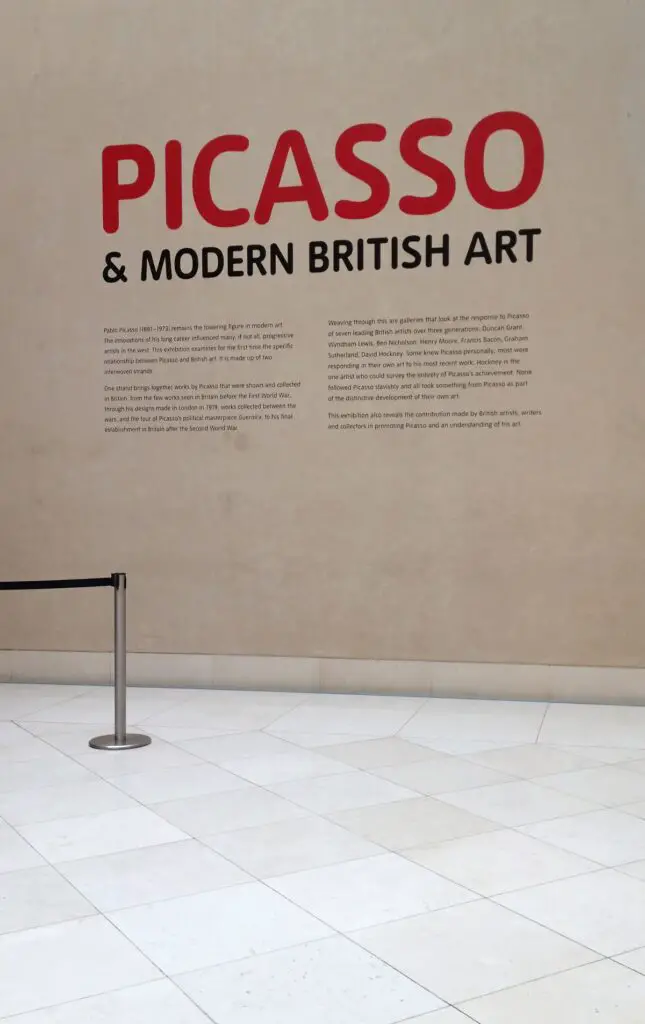
Surveying Pablo Picasso’s vast repertoire of self-portraits offers more than just an understanding of his artistic evolution; it offers an intimate portrait of the artist. These self-portraits resonate with audiences, forming a connective tissue between Picasso’s time and ours, illuminating his experiences, playing with convention, and inviting interpretation.
They stand as a testament to the enduring relevance of his legacy; his innovations continue to serve as reference points to contemporary artists. Picasso’s self-portraits reverberate through the vast expanses of the art world, painting a nuanced picture of his sophisticated thought process, subconscious mind, and intimate self-perceptions. Thus, they serve as an eternal testament to Picasso, the man beyond the artist, and his indelible footprints on the sands of artistic expression.
Explore how Picasso assimilated Cézanne’s ideas while maintaining his own artistic identity, distinguishing his work from a mere replication of Cézanne’s style.
Listen To Our Podcast About What Makes Picasso’s Self-Portraits So Captivating?
Below or By clicking here.
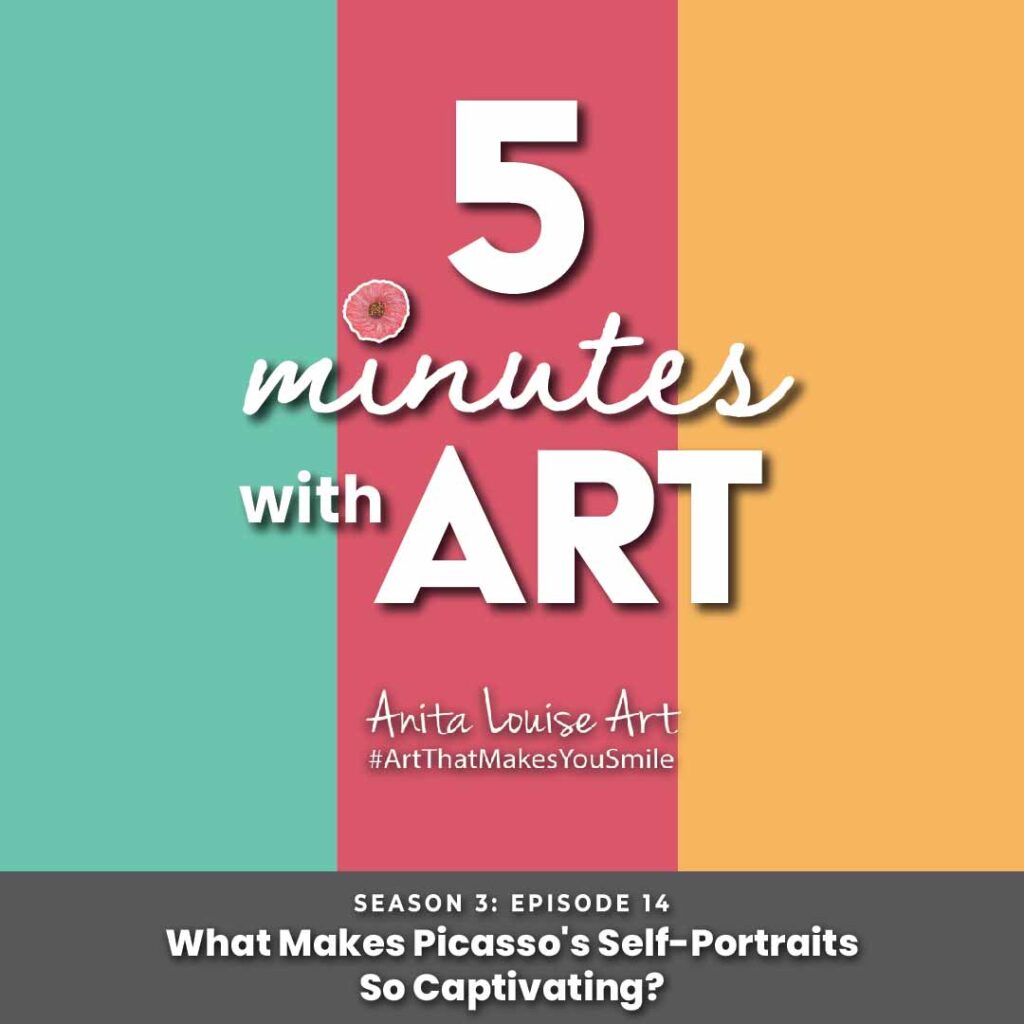
Anita Louise Art is dedicated to art education, great artists, and inspiring others to find and create their art. We love art that uplifts and inspires. #ArtToMakeYouSmile! #ArtToMakeYouHappy!
If you want to see any of my art, you can find out more by clicking here. If you are interested in what inspires me and my paintings, you can discover more by clicking here.
We have a free newsletter and would love you to be part of our community; you can subscribe to the newsletter by clicking here. If you have any questions, I would be happy to talk to you anytime. You can reach me, Anita, by clicking here.
Subscribe to our Anita Louise Art YouTube Channel with great videos and information by clicking here.
Join us for our podcast “5 Minutes With Art.” just 5 minutes a week with us to discover and learn about great art and artists. You can find out more about our podcast by clicking here.
Related Questions
Why Do People Say,” Life Is Like Drawing Without An Eraser?
Many times, artists, myself included, will use an eraser to remove any marks or measurements we may have made on a paper to measure out and organize their drawings or artwork on their canvas or paper. For most artists having a good eraser is essential.
By clicking here, you can learn more by reading Why Do People Say,” Life Is Like Drawing Without An Eraser?.
Is Communism Good For The Arts?
Communism is not suitable for art and for many artists under Communism the art should have a purpose and way to help further the communist ideals and ideology. In a Communist society, many artists are labeled as dissidents; others are forced to use their talents to create propaganda art.
By clicking here, you can learn more by reading Is Communism Good For The Arts?.
12 Years Leonardo Painted Mona Lisa’s Lips, Facts Or Fiction?
There is no evidence to show that Leonardo da Vinci spent 12 years painting the Mona Lisa smile. Most scholars believe that he painted the painting in 4 years but then had the painting much longer in his possession. He could have worked on it a bit or adjusted it when he had it in his possession, but there is no evidence to show that.
By clicking here, you can learn more by reading 12 Years Leonardo Painted Mona Lisa’s Lips, Facts Or Fiction?

